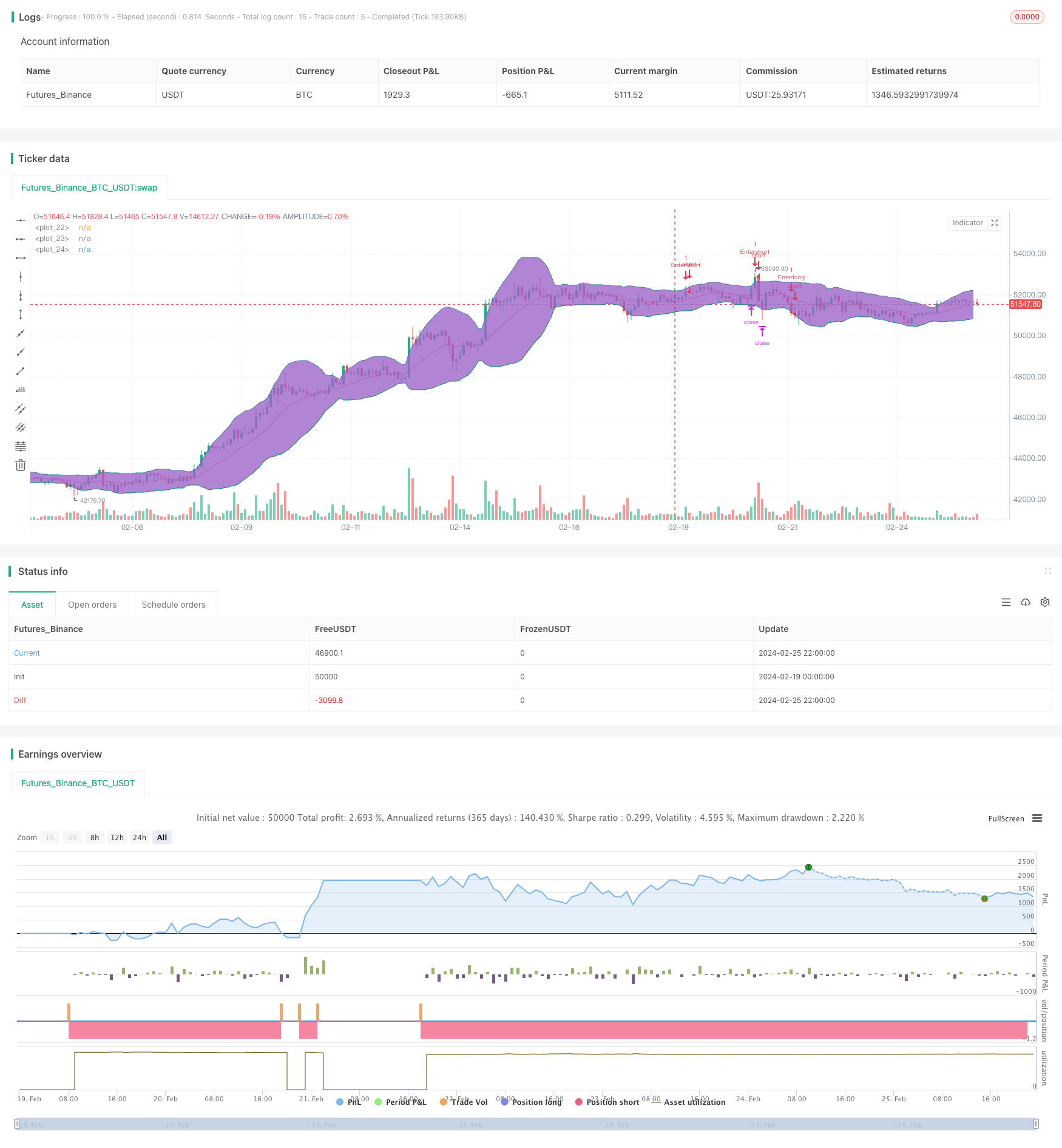
概述
此策略运用玻尔兰德波带指标,结合跟踪止损,实现趋势跟踪交易。当价格突破上轨时做空,当价格跌破下轨时做多,设置止损和止盈价格,以锁定收益。同时,该策略还提供可选的反转入场选择,即当价格重新进入波带时反向做单。
策略原理
该策略首先计算布林带的中轨、上轨和下轨。中轨为长度为Len的WMA均线,上轨和下轨距离代表标准差的倍数Deviation。
当价格上穿上轨线时,做空;当价格下穿下轨线时,做多。开仓后设置止损和止盈价格。止损价格为输入的Stop值,止盈价格为输入的Limit值。
此外,策略还提供反转开仓的选择。勾选“Reversal Entry”后,价格重新进入布林带时做反向单,属于MEAN REVERSION交易方式。
无论顺势开仓还是反转开仓,止损和止盈设置都相同。止损和止盈均有两个选择,固定止损或移动止损。后者trailers stop会根据价格变化进行调整。
优势分析
该策略结合布林带指标和跟踪止损,能够有效控制风险,同时锁定趋势获利。反转开仓方式可以减少止损被触发的概率。
布林带上下轨能清晰判断价格突破,波段交易方式使盈亏结果明朗。跟踪止损调整止损位置,防止获利被套。
风险分析
布林带策略最大的风险在于趋势反转。突破上轨做空后,价格可能出现V型反转,导致快速止损。做多情况也类似。
反转开仓方式可能错过趋势延续机会。价格重新进入波带后做反向单,可能使利润减少。
此外,参数设置不当也会导致风险放大。Len和Deviation需要谨慎设置,否则将增加止损风险。
优化方向
该策略可以从以下几个方面进行优化:
增加参数自适应功能。Len和Deviation可以根据市场波动程度进行动态调整,使布林带更贴近价格。
增加开仓过滤条件。可以添加交易量突增、成交笔数增加等额外条件,避免被套。
结合其他指标过滤信号。比如MACD,KDJ等指标判断趋势性,避免错漏信号。
增加时间限制。只在特定时间段交易,可以减少隔夜风险。
总结
该玻尔兰德波带跟踪策略,使用布林带指标判断价格突破。设置止盈止损锁定收益,运用跟踪止损调整风险。策略简单实用,可根据市场选择顺势或反转交易。通过参数优化和条件过滤,可以将风险进一步降低,从而获得更稳定的收益。
/*backtest
start: 2024-02-19 00:00:00
end: 2024-02-26 00:00:00
period: 2h
basePeriod: 15m
exchanges: [{"eid":"Futures_Binance","currency":"BTC_USDT"}]
*/
//@version=4
strategy(title="BB Strategy (Basic)",overlay=true, initial_capital=25000, default_qty_value=1, commission_type=strategy.commission.cash_per_contract, commission_value=3.02)
len = input(20, minval=1, title="Length")
src = input(close, title="Source")
mult = input(2.0, "Deviation", minval=0.001, maxval=50)
//price_drop = input(.003, "When price drops (In Ticks) Enter Long", step=.001)
//price_climb = input(.003, "When price climbs (In Ticks) Enter Short", step=.001)
trail = input(true, "Trailing Stop(checked), Market stop(unchecked)")
stop = input(10000, "Stop (in ticks)", step=5)
limit = input(20000, "Limit Out", step=5)
//size = input(1, "Limit Position Size (pyramiding)", minval=1)
revt = input(true, "Reversal Entry(checked, Trend Entry(unchecked)")
timec = input(false, "Limit Time of Day (Buying Side)")
//calculations and plots
revti = if revt==false
true
basis = wma(src, len)
dev = mult * stdev(src, len)
upper = basis + dev
lower = basis - dev
plot(basis, color=red)
p1 = plot(upper, color=teal)
p2 = plot(lower, color=teal)
fill(p1, p2)
u = crossover(high, upper)
d = crossunder(low, lower)
//Time Session
sess = input("1600-0500", "Start/Stop trades (Est time)")
t = time(timeframe.period, sess)
//Orders
if(timec)
strategy.entry("Enterlong", long=revt, when=d and t>1)
else
strategy.entry("Enterlong", long=revt, when=d)
if(trail)
strategy.exit("Exit","Enterlong", profit=limit, trail_points = 0, trail_offset = stop )
else
strategy.exit("Exit","Enterlong", profit=limit, loss = stop )
if(timec)
strategy.entry("Entershort", long=revti, when=u and t>1)
else
strategy.entry("Entershort", long=revti, when=u)
if(trail)
strategy.exit("Exit","Entershort", profit=limit, trail_points = 0, trail_offset = stop )
else
strategy.exit("Exit","Entershort", profit=limit, loss = stop )